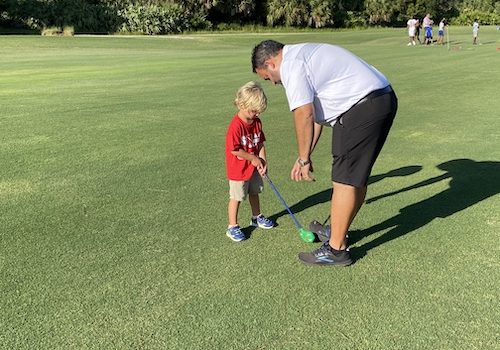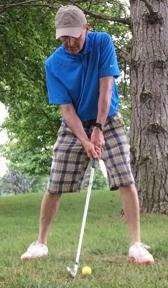
Driving Range Tips

Whether a golfer is visiting a driving range as a beginner or master, there are a few tips to keep in mind. These tips will assist the golfer to target their practice while at the range.
Before we get into our helpful tips to help our fellow golfers out when they go to driving ranges, let’s briefly touch on how to prepare for the driving range.
The range is a place for golfers of all ages and experience levels. At a driving range, golfers can practice for as long as they want to without fear of holding other golfers up on the golf course. The time at a range should be specific. Golfers should arrive at the driving range with a goal in mind and practice techniques to assist in reaching that goal.
Two reasons or goals individuals may visit a driving range to work on attaining are improving a swing or getting used to a new club. If a golfer arrives at the range without a purpose, they won’t see their golf game improving. Improving a golf score is done through targeted and thoughtful attention to detail and critical thinking of golf strategies.
Preparing for the Driving Range
Before picking up a club and working on perfecting a swing, a golfer should always stretch!
Stretching helps to warm up the muscles used while golfing. In addition, stretching helps loosen a person’s body to prevent injuries. Warming up muscles like the hamstring, quad, arms, back, and neck before reaching for that golf club is vital for injury prevention. Moreover, stretching allows for more range of motion when on the range practicing swings.
We recommend using at least these three stretches before working on perfecting a swing:
- The Twist Stretch
- The Scarecrow Stretch
- The Standing Side Stretch
Check out our blog on golf stretches here for detailed steps for these stretches.
Improving Your Swing at the Range
The most common shot at a driving range to practice and improve is the driving golf shot. A driving golf shot is typically made from the tee box. The benefits of improving this type of swing include:
- Saving time on the golf course.
- Improving a golfers score.
- Increasing the distance the golf ball will travel.
A golfer will improve their driving swing by using these three tips:
- Practice the fundamentals
- Create a Pre-Drive Strategy
- Try various strategies for game improvement

Types of Driving Range Practice
While at the range, golfers may choose to focus on practicing grip, foot stance, posture, or swings. These will fall into two types of practice. Rote and situational are the two types of practice sessions a golfer will choose from while at the range. During either rote or situational practice sessions, a golfer should choose one aspect of their game to focus on improving.
A golfer can use both rote and situational to improve a singular aspect of their golf game. Or they may decide to focus only on rote instead of situational training for their driving range session.
Rote Practice
Rote practice is when golfers work on muscle memory. Muscle memory is essential for every aspect of golf. These motions should be second nature to a golfer, from feet placement to the golfer’s follow-through in a swing.
The importance of the precise placement of hands, feet, and eyesight is why every golfer, from the beginner to the professional, should always do muscle memory drills.
Golfers use the rote type of practice session with or without clubs and golf balls. Although, for beginners, rote practice without clubs and golf balls will aid in emphasizing hand, feet, and eyesight placement.
During rote practice, a golfer should focus on where they place their hands, feet, and eyesight. Additionally, golfers should note how their muscles feel holding the club, standing on the green, and the movement before, during, and after they go through the motions of a particular swing.
Situational Practice
Situational practice is when golfers work on game management. During game management practice, a golfer will work on their critical thinking skills to resolve a situation they might find themselves in on a golf course.
Rather than keeping this type of drill session boring, liven it up with unique situations. Have fun and be creative. Think about what could happen on the green, and think through the problem. Try this thought process:
- Identify the problem.
- Determine which club to use and why.
- Picture the handgrip, stance, and swing in your mind.
- Practice the handgrip, posture, and swing with a golf ball.
- Evaluate how practical the club and swing are in this situation.
- Swing and hit the golf ball.
- Re-evaluate the method and club used.
- Was the correct club chosen?
- Was there anything about the shot that should’ve been addressed?
- Brainstorm solutions for preventing the situation from happening on the golf course.
Perfect Your Golf Game With IRGF
Golf is a sport for the ages. One can start at any age to learn the basics of golf or even master the art of golf. Indian River Golf Foundation is here to assist golfers, from beginners to life-long players, improve their golf skills. We have golf mentors for every type of golfer, regardless of experience level.
Want to join our foundation in Indian River County? If so, please contact the Founder and President of IRGF, Roger Van Dyke. He is available by email at rogervandykeirgf@gmail.com or by phone at 772-713-9593. We have many different training options, such as player development and after-school training.
We’d look forward to helping all improve their game and develop life skills through golf.




This Post Has 0 Comments